
No-till gardens grow more grub
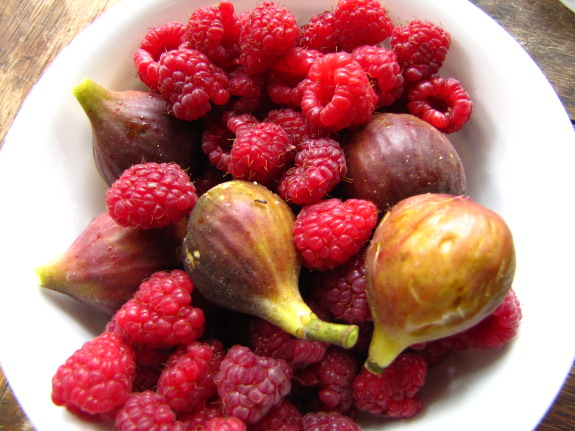
This year, I've been
learning the dangers of no-till gardening --- you may accidentally
produce enough to feed a small army.
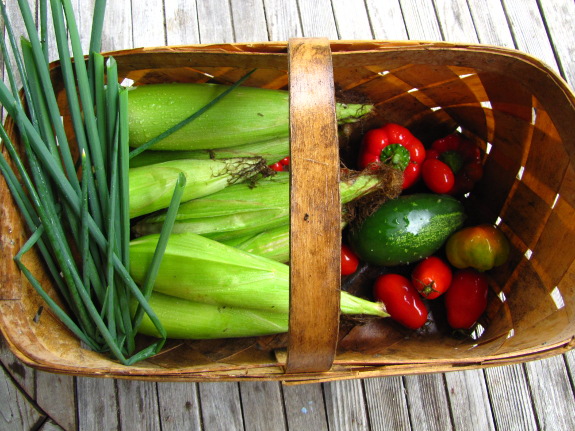
Of our three varieties
of garlic, two
produced significantly more weight per bed in 2012 compared to 2011. Music stayed the
same, but I got 42% more garlic from the Silverwhite Silverskin and a
whopping 88% more from the Italian Softneck.
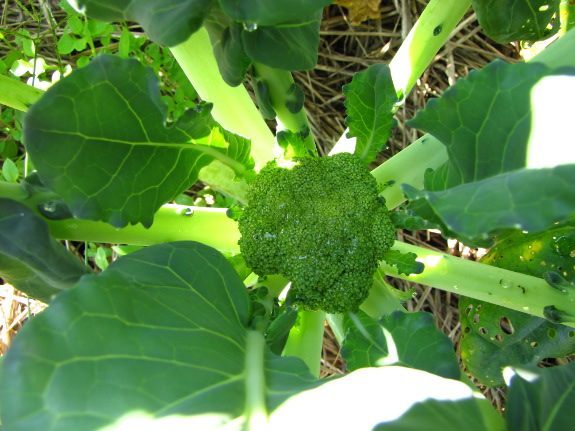
But that's
nothing. Last year's
sweet potatoes averaged 9.8 pounds per bed, giving us a total haul of
78.5 pounds of sweet tubers. That was way too much for us to eat,
so I cut our planting in half this year...and came up with a 83.5 pound
harvest! Yes, that's an increase of 114% per bed over last
year. (Guess what all of my local friends are getting for
autumnal equinox presents?)
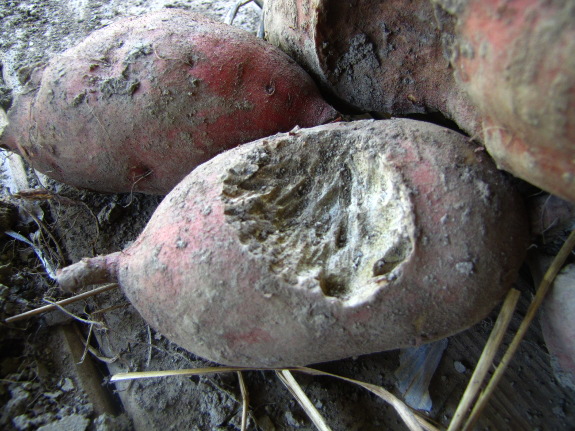
Granted, there have been
some downsides. Perhaps a tenth of the sweet potatoes had been
gnawed on by soil-dwelling critters despite Lucy's best efforts to dig
the garden apart in search of voles. But given such high
productivity, I don't mind cutting out a few teeth marks.
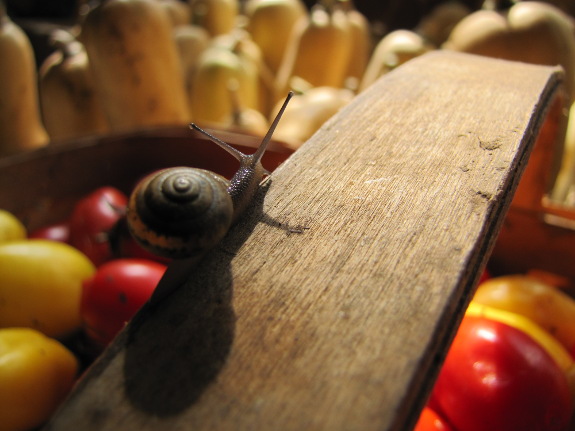
And, to be entirely
fair, I think this year's increase in sweet potato production is also
due to two other factors. First, we only had one tiny deer
incursion this summer, and sweet potatoes always suffer the worst when
deer come to call. Equally important is the fact that I gave the
sweet potatoes part of the loamy front garden --- the two beds I
planted on the dividing line between loam and clay produced much less
than the other two beds did.
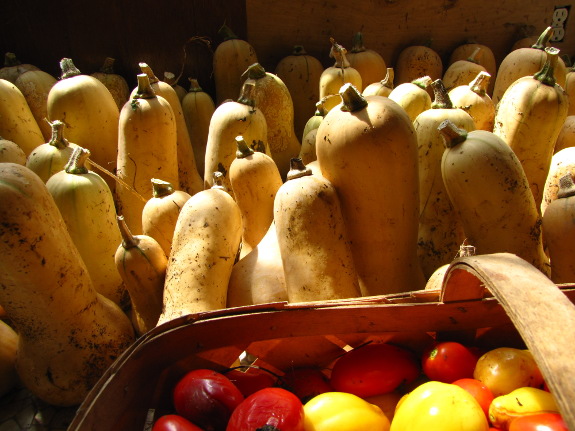
We don't weigh most of
our produce, so I can't tell you whether we saw increased production
among our corn, beans, squash, tomatoes, greens, and the multitude of
other vegetables we grow. But we sure had plenty to eat and
preserve this year.
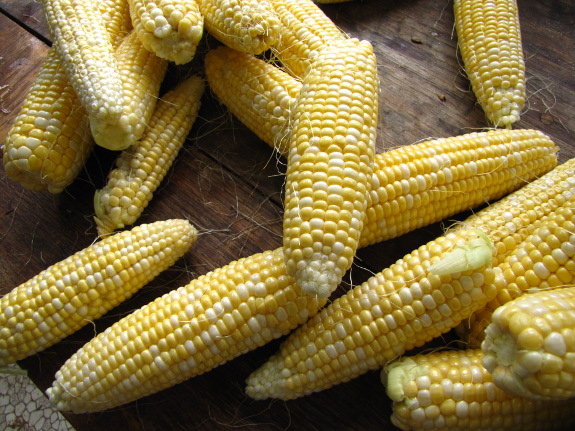
And I attribute a large
part of that success to the health of our soil. Doesn't that make
you want to at least try no-till on a few beds next year?
(By the way, all of the
photos in this post are from this week's healthy haul of late summer
crops.)
Want more in-depth information? Browse through our books.
Or explore more posts by date or by subject.
About us: Anna Hess and Mark Hamilton spent over a decade living self-sufficiently in the mountains of Virginia before moving north to start over from scratch in the foothills of Ohio. They've experimented with permaculture, no-till gardening, trailersteading, home-based microbusinesses and much more, writing about their adventures in both blogs and books.
Want to be notified when new comments are posted on this page? Click on the RSS button after you add a comment to subscribe to the comment feed, or simply check the box beside "email replies to me" while writing your comment.

What variety of Butternut squash do you grow, Or which one did you start with? Iv been trying to grow Butternut for years. The problem is I can only find the variety Waltham. It would be very productive if it produced male flowers for me. It doesn't though, they just never mature like the female flowers. Thanks.
Wow, that's a lot of butternut & sweet potato!
I so wish I could do no till gardening. In fact I am trying it in the herb & flower garden. But I'm trying to convert lawn space that seems to consist of patches of Bermuda grass and masses of quackgrass. So far the quackgrass is entirely happy to grow 6+ foot long winding rhizome under all my mulching efforts (so far newspaper and cardboard with shredded hardwood on top). It just grows and grows until it finds sunlight or a thinning patch of mulch. It especially loves to grow inside the cardboard. Grows up and over any barriers I put down and then works its way into the mulch from the top too.
After reading about your success with no-till gardening I'm very interested in trying it out but where I live our ground is VERY HARD. I have 3 separate gardens, my root vegetable is 6ft wide and 500ft long, the majority of that garden is potatoes and also carrots, parsnips, beets, radishes, onions, garlic, shallots. I always thought it was necessary to till that garden to soften the ground enough for those crops to do well. I guess I'll be researching no-till some more before next year. I still have a lot of learning to do, I'm 25 and have only been growing my own garden for the past 4 years.
T --- This is totally unlike me, but I don't know what kind of butternut I'm growing. The original seeds were from Seeds of Change in 2008, but they didn't list any variety. The one they're currently selling is described as a "productive Waltham strain", but we haven't had any trouble with no male flowers being produced.
Laura --- My father has trouble with running grasses too --- they seem pretty awful! I think I read somewhere about someone putting down a rhizome barrier, like you might do with mint or bamboo, around the whole garden, then finding a way to kill all the grasses inside. But I can't speak about that from personal experience.
Bo --- I've found that poor soil improves much faster if managed no-till than if tilled. While it seems like you fluff up the soil when tilling, you actually destroy the soil structure and oxidize organic matter, so troublesome spots get more and more troublesome. With no-till, worms thrive and organic matter gets mixed deep into the soil. Add in cover crops (oilseed radishes especially), and in a few years you'll have great soil!
Bo, this past summer I did a no till potato patch. I did get more potatoes out of it then planting the usual way. I have bed rock so putting a layer of manure, cardboard, loose straw, forest litter and and finishing it off with a good layer of top soil. Now I did mix in some branches from the forest litter and the potatoes loved to scoot their little buttoms into the creveses that the branches made in the bed.
I have created 2 more no till, raised beds that are a mixture of lazagnia and huggle culture. And I am working on a third one next to the older one. I have coliflour growing in one new bed and am trying to sprout peas in the old bed.
Give it a try, you'll love it.
Bo --- I tried crimson clover, but it didn't seem to be a no-till winner. Unfortunately, it's too late to plant my favorite, no-till, winter cover crops, so your best bet is probably just to mulch the ground heavily and wait until spring. Check out our cover crop tag for lots more information on our trials and errors with cover crops in a no-till system.
Harvesting potatoes (and carrots, etc.) is the one time I really disturb the soil in my garden. There's no real alternative to just digging them up! I do tend to just dig where the plants are, though, which keeps the intrusion to a minimum. I figure a few little tubers left behind isn't the end of the world.
I generally sprinkle small seeds on the surface to sow, or make shallow trenches with my hoe for larger seeds (like peas) or for seed potatoes. I've got a lot of basic information on planting a no-till garden in my book, which should help you out, I hope!
Good luck converting to no-till!
I'm putting in a big new garden area for next spring. This big flat area was used as RV and trailer parking by the previous owners, so this dirt is hard packed!! I figure if no- till will work here, it'll work anywhere!n half of the soil is decent and half is awful awful pumice and pretty useless. The biggest challenge will be finding enough good compost. I've scouted out cardboard, I can dig manure ( uncomposted) from the neighbors horse corral, but the actual good digested compost is going to be harder. I'll get some from my compost bin, but not nearly enough! Do you think if I put tons of fairly new horse manure on the top, it will be ready by spring for a growing medium? Thanks, deb
Deb --- Too bad you just missed the boat for winter cover crops --- oilseed radishes probably would have perked that area right up.
I add semi-raw horse manure all the time. The only downside is that weed seeds will sprout, and if you don't mix in soil it sometimes crusts up during dry weather if you scatter seeds directly on top. But if you take those issues into account, you should be fine.
I'll be very curious to hear the results of your experiment!
Anna, yep, my timing is often too late! But I will try it and see what happens. I started a second compost bin and will add some more red worms - hope that'll get it moving and produce more good stuff by next spring. But I am in zone 5 and winter is approaching!
But I will try it and see what happens. I started a second compost bin and will add some more red worms - hope that'll get it moving and produce more good stuff by next spring. But I am in zone 5 and winter is approaching!
It's a challenge here for sure.
Now if I can only keep the: Deer Bears, Free range cattle out of it! ( they're the worst!)